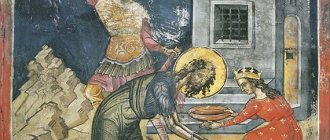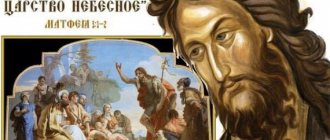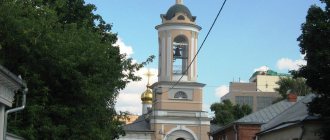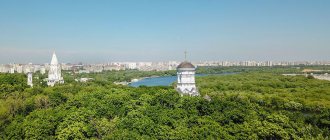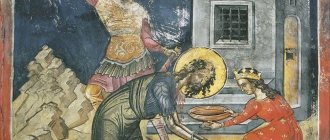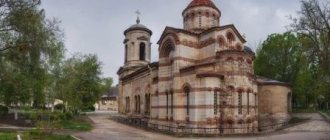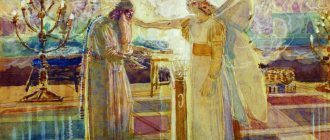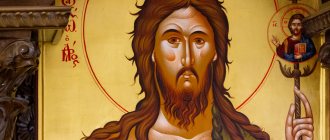John the Baptist is known throughout the world as a saint and prophet who suffered martyrdom. The story of his life and death, which became both tragic and instructive, is contained in the pages of the New Testament. On icons, John the Baptist is often depicted differently from other saints - holding his own head in his hands. Such an expressive detail emphasizes his earthly suffering, humbly accepted in the name of the teachings of Christ.
Life path of John the Baptist
John the Baptist was born in Hebron, into the family of a true believer Jewish priest. This event occurred shortly before the coming of Jesus Christ into the human world. John's parents were the God-fearing Zechariah and Elizabeth, who had never had children before. The birth of the future saint was preceded by the appearance of an archangel to his father, who said that the boy would carry out an important mission and would become a great prophet and Forerunner of the Messiah.
John's earthly life was not easy: by order of King Herod, his parents were killed, and he himself was forced to flee persecution. The prophet lived alone in a cave in the Judean desert. Here the Forerunner remained until he was 30 years old. All this time, he tirelessly prayed to the Lord, led an ascetic lifestyle and baptized people who wanted to become Christians.
John was called the Baptist because he performed the baptismal rite over the Savior at His own request. A great biblical event took place in the Jordan River. On the day when Jesus Christ was baptized, the appearance of the Holy Spirit occurred and the voice of God the Father was heard loudly, calling the Messiah “beloved Son.”
Testimonies about John the Baptist are found in all four Gospels
The Life of Saint John the Baptist is written on the basis of all four Gospels since he is mentioned in all of them. As for such an event as the birth of John the Baptist, he and his childhood are known only from the story of the Apostle Luke.
So the apostle says that John is the son of the priest Zechariah and the righteous Elizabeth. John's father was “from the line of Abia”; his mother came from the family of Aaron.
Righteous Zechariah. Mosaic from the monastery of Hosios Loukas. 30s XI century When Archangel Gabriel brought the news of the imminent birth of his son to the father of Saint John the Baptist, righteous Zechariah, he did not believe him. For this Gabriel punished him with muteness.
The Baptist's parents waited a long time for a child, but he was not born to them. As the same Evangelist Luke says, the Archangel Gabriel appeared to Zechariah in the Temple and told him about the imminent birth of his sons, who would not drink alcohol, would be Great before the Lord and would be filled with the Holy Spirit through his mother’s womb.
Zechariah expressed distrust of the angel, and for this he punished him with muteness.
The mother of John the Baptist, the righteous Elizabeth, is a relative of the Virgin Mary.
The Virgin Mary found out that Elizabeth, her relative, was pregnant and came to visit her. At that moment the baby (John) leaped in her womb.
Thus, John predicted the Messiah to his mother while still in the womb. The Gospel says that the birth of the saint occurred six months earlier than his relative Jesus.
Visit to Elizabeth. Jacques Dare. 1434-1435. The Virgin Mary, having learned that her relative Elizabeth was pregnant, came to visit the righteous woman. At this time, baby John jumped in his mother’s womb, welcoming Jesus
Punished by the Archangel Gabriel, Zechariah remained mute when Elizabeth decided to give her son the name John, indicated by the angel, which was unconventional for her family (“Yahweh (God) had mercy”). That is why he had to confirm this fact in writing to his relatives (Luke 1:63-66).
As for John’s childhood, the Gospel briefly says this:
OK. 1:80
“...was in the deserts until the day of his appearing to Israel.”
In addition, it is also known that his father was killed by the servants of King Herod in the Temple.
Martyrdom of the Prophet
John the Baptist was killed by order of King Herod Antipas, whom he openly condemned for committing adultery with his brother's wife. The prophet, who dared to point out his sins to the ruler, was imprisoned, but was not executed immediately because of the great love of the people for him.
At one of the feasts, Herod's stepdaughter named Salome, who was the daughter of his mistress Herodias, delighted everyone present with a beautiful dance. When the king asked the girl what reward she dreamed of, Salome asked for the severed head of John the Baptist on a platter. The terrible desire was not her own, but came from her mother, who hated the prophet.
On the same day, Salome's request was fulfilled. After the executioner cut off the head of John the Baptist, it was immediately delivered to the dancer on a platter. There is information that the martyrdom of the prophet was not enough for her mother Herodias, so the woman desecrated her head by pricking it with a knife.
According to legend, King Herod and all the participants in the events described paid severely for the murder of the saint. The ruler and his mistress were expelled into eternal exile, and then fell underground during an earthquake. Salome died under tragic circumstances, losing, like John, her own head.
After his stay in the desert, John the Baptist began to preach
Acrids
This is a type of food characteristic of the poorest strata of the population. John ate it
Evangelist Luke says that in the desert John the Baptist, by God’s Will, acquired the gift of speech. After this he began to preach.
Article "Akrida" on hranitel.club
From that moment on, he began to lead an ascetic lifestyle, wearing rough clothes made of camel hair and a leather belt, eating wild honey and locusts (a type of locust or a certain type of plant, according to some opinions) (Mark 1:6).
Sermon of Saint John the Baptist. Icon. John the Baptist began preaching in the country of Jordan in 28-29 AD. He called on sinners to be baptized for the forgiveness of sins
St. John began preaching in 28 or 29 AD. He walked around the country of Jordan and called for baptism for the forgiveness of sins. John's preaching expressed God's wrath against sinners and calls for repentance, as well as an estalological message.
He reproached the people for being proud of their chosenness (especially the Sadducees and Pharisees), and demanded the restoration of patriarchal norms of social ethics.
The Prophet John was also distinguished from an ordinary preacher by the fact that he conveyed God's will to people. Jesus Christ pointed to John as the coming of the prophet Elijah, who was expected (Matthew 11:14, Matthew 17:12).
John the Baptist answered the priests and Levites that he was neither Elijah nor a prophet, but:
In. 1:26-27
“I am the voice of one crying in the wilderness: straighten the way of the Lord, as the prophet Isaiah said.” In addition, to the question of the Jerusalem Pharisees, John answered: “I baptize in water; but there stands among you [Someone] whom you do not know. He is the one who comes after me, but who stands in front of me. I am not worthy to untie the thong of His sandals.”
The appearance of Christ to the people.
Alexander Ivanov. 1834-1857. When John the Baptist was preaching, he saw Jesus approaching him, who received Baptism from him. The very next day Jesus came to John the Baptist. Seeing the Savior approaching him, the saint said:
In. 1:29-31
“behold the Lamb of God, who takes away the sin of the world...”
This was followed by the Baptism of the Lord.
The fate of the remains of John the Baptist
After the execution of the Forerunner, his remains were returned to the disciples, who buried the prophet in the city of Sebastia. At that time, there was no tradition of burying the body. According to a long-standing Christian custom, the dead were placed in stone coffins and left in caves.
This is exactly how John the Baptist was buried, but in the 4th century his ashes were rudely disturbed. This happened under Emperor Julian the Apostate, on whose initiative the people began to return to pagan cults. By order of the ruler, the body of John the Baptist was removed from the tomb and burned, after which the ashes were scattered. That is why today all the remains of the prophet do not exist, but his grave has been preserved. Later, an Orthodox church was erected at the saint’s burial site, which was later replaced by a Muslim mosque.
The head of John the Baptist was immediately buried separately from his body. First, the prophet's followers placed her in a consecrated vessel and buried her on the Mount of Olives. The shrine was not able to rest peacefully, since in the future it had to go through many wanderings.
The name of Saint John has two epithets: “Baptist” and “Forerunner”
Saint John the Baptist is revered not only in Christianity. So Muslims, Mandaeans and Baha'is revere him under the name Yahya (Yahya), Christian Arabs - under the name Yuhanna.
In addition, the name of the saint also has two epithets: “Baptist” and “Forerunner”. This is due to the fact that he baptized Jesus Christ, and also came in accordance with the Old Testament prophecies with the sermon.
John the Baptist, fragment of the Bardi altar. Sandro Botticelli. 1484-1485. For the first time, the Gnostic Heraklion called St. John the Baptist in his writings
In the New Testament, the word "Forerunner" is applied to Christ, not John the Baptist (for example, in Hebrews 6:20). The Gnostic Heracleon first calls him this in his commentary on the Gospel of John.
Later this designation was adopted by Clement of Alexandria and Origen. It is this word that has come into widespread use, and it is worth noting that in Orthodoxy both epithets are used almost equally often, while in the West priority remains with the name “Baptist.”
The full name of the saint in Orthodoxy is as follows:
"Prophet, Forerunner and Baptist of the Lord John."
The story of the prophet's head
The head of John the Baptist is considered the most important Christian relic, which many states of the world at one time sought to possess. During the entire time that passed after the martyrdom of the great prophet, his head was found three times.
First discovery of the shrine
First, the head of John the Baptist was found by a certain nobleman Innocent, who bought territory near the Mount of Olives. Realizing the value of this relic, and being a God-fearing man, he again hid it in the ground, and erected a Christian temple over the burial site. In subsequent centuries, the shrine was considered lost, but its location was indicated by the prophet himself, who appeared in a dream to one of the monks. As a result of disrespectful treatment of the relic, it disappeared again without a trace.
Second Finding
In 452, an event occurred known as the Second Finding of the Head of John the Baptist. The shrine was discovered by a monk named Marcellus. The head of the prophet was found by him in Emessa, after which it was transported to Constantinople. In this city it was carefully protected for several centuries.
Third discovery
In the capital of Byzantium, the head of John the Baptist remained until the onset of the period of iconoclastic heresy, then it was taken out by pious Christians. When the Council of Constantinople in 843 restored the tradition of icon veneration, the shrine was returned to its original place. It is believed that this event, which went down in the history of Christianity as the Third Finding of the Head of John the Baptist, took place on May 25, 850.
Subsequently, the honest head of the great prophet was divided into parts. One fragment of it was in the monastery of Petra, the other in Amiens in northern France. Particles of the relic also ended up in the Dionysian Monastery on Mount Athos, the Ugrovlahia monastery of Kalui, and the papal church in Rome. During one of the crusades, part of the relic ended up on the territory of Abkhazia, where it was buried in a temple tomb.
The unknown story of the head of the Baptist of the Lord John
Icon of St. John the Baptist
Sacred Tradition tells us that after the beheading of the head of Saint John the Baptist, the wicked Herodias did not allow it to be buried along with the body of the saint, but, having violated it, buried it near her palace. The saint’s disciples secretly took the body and buried it. The wife of King Herod's henchman knew where Herodias buried the head. And she decided to rebury her on the Mount of Olives in one of Herod’s estates.
When rumors about Jesus' preaching and the miracles he performed reached the royal palace, Herod and his wife Herodias went to check whether the head of John the Baptist was still there. Not finding her, they began to think that Jesus Christ is the risen John the Baptist. The Holy Gospel testifies to this error of theirs (Matthew 14:2).
Jerusalem. First discovery of the head of John the Baptist
Many years later, during the reign of Equal-to-the-Apostles Tsar Constantine, his mother Saint Helena restored the Jerusalem shrines. Many pilgrims began to flock to the Holy Land, among whom two monks from the East came to venerate the Holy Cross and the Holy Sepulcher. Saint John entrusted them with finding his head. We only know that he appeared to them in a dream, and that after finding the head in the place he indicated, they decided to return back. However, God's will was different. On the way, they met a poor potter from the Syrian city of Emesa, who, due to poverty, was forced to go in search of work in a neighboring country. The monks, having found a traveling companion, out of negligence or laziness, entrusted him with carrying the bag with the shrine. And he carried it to himself until Saint John the Baptist appeared to him and commanded him to leave the careless monks and run away from them along with the bag entrusted to him.
The Lord, for the sake of the head of John the Baptist, blessed the potter's house with all abundance. The potter lived his entire life, remembering what he owed and to whom, he was not proud and gave alms abundantly, and shortly before his death he handed over the head of the saint to his sister, commanding him to pass it on to God-fearing and virtuous Christians.
The head of the saint, passing for a long time from one person to another, fell into the hands of Hieromonk Eustathius, a supporter of the Arian heresy. Sick people who turned to him received healing, not knowing that the reason for this was not the imaginary piety of Eustathius, but the grace emanating from the hidden head of him. Soon Eustathius's trick was discovered, and he was expelled from Emesa. And around the cave where the hieromonk lived and in which the head of John the Baptist was buried, a monastery was formed.
Emesa and Constantinople. The Second and Third Findings of the Honest Head
After many years, the second discovery of the head of St. John took place. This is known from the description of Archimandrite Markell of the Emesa monastery, as well as from the life of the Venerable Matrona (her feast day is November 9), written by the Venerable Simeon Metaphrastus. According to the description of the first, the chapter opened to him on February 18, 452. A week later, Bishop Uranius of Emesa began venerating her, and on February 26 of the same year she was transferred to the newly created church in honor of St. John. This event is celebrated on February 24 along with the celebration of the first acquisition of an honest head.
After some time, the head of the Baptist John was transferred to Constantinople, where it remained until iconoclastic times. Pious Christians, leaving Constantinople, secretly took with them the head of John the Baptist, and then hid it in Komani (near Sukhumi), the city in which St. John Chrysostom once died while in exile (407). After the VII Ecumenical Council (787), which restored the Orthodox veneration of icons, the head of St. John the Baptist was returned to the Byzantine capital around 850. The Church celebrates this event on May 25 as the third finding of an honest head.
The Fourth Crusade and the Journey to the West
The story of the chapter of St. John usually ends with the story of the third finding. This is due to the fact that its further history is connected with the Catholic West. If we turn to the lives of the saints, set out according to the guidance of the Chetya-minya of St. Demetrius of Rostov, then at the end of the description of the acquisitions of the head of the holy Forerunner we will find a footnote, typed in small print, and therefore often missed by readers. But for us, who quite unexpectedly found the head of the Baptist several years ago in France, this footnote upon returning to our homeland was a real discovery. We would like to talk below about the next “discovery” of the head of John the Baptist in the far West.
So, in a footnote we can read that after 850 part of the chapter of St. John ended up in P e
three in the Prodrom monastery, and the other part in the Studii Forerunner Monastery. In this monastery, the top of the dome was seen by the pilgrim Anthony back in 1200. However, already in 1204 it was moved by the crusaders to Amiens in northern France. In addition, the footnote indicates three other locations of the fragments of the chapter: the Athonite monastery of Dionysius, the Ugrovlahian monastery of Kalui and the church of Pope Sylvester in Rome, to which the particle of the relics was transferred from Amiens.
The front part of the head of St. John the Baptist in the Cathedral of the Blessed Virgin Mary in Amiens. Photo: “Orthodox France” / https://la-france-orthodoxe.net/ru/galer/jean
The history of the appearance of the head of St. John in France is not much different from the history of many other greatest shrines of Christianity.
On April 13, 1204, during the Fourth Crusade, troops of Western knights captured the capital of the Roman Empire - Constantinople. The city was devastated and plundered.
As Western legend says, Canon Vallon de Sarton from Pikinia found a case containing a silver dish in the ruins of one of the palaces. On it, under a glass cover, the remains of a human face were hidden, only the lower jaw was missing. A small hole was visible above the left eyebrow, probably made by a blow from a dagger.
On the dish, the canon discovered an inscription in Greek, confirming that he was the owner of the relics of St. John the Baptist. In addition, the presence of a hole above the eyebrow was consistent with the event mentioned by St. Jerome. According to his testimony, Herodias, in a fit of anger, struck the saint’s severed head with a dagger.
Cathedral of the Blessed Virgin Mary in Amiens (Notre Dame d'Amiens). Photo: SPADEM – Editions d'art Yvon
Vallon de Sarton decided to deliver the head of the holy Forerunner to Picardy, in the north of France.
On December 17, 1206, on the third Sunday of Nativity Lent, the Catholic Bishop of the city of Amiens, Richard of Gerberoi, solemnly greeted the holy relics of John the Baptist at the city gates. Probably, the bishop was confident of the authenticity of the relics, which was easier to verify then, as they say, “without delay.” From this time on, the veneration of the head of St. John began in Amiens and throughout Picardy.
In 1220, the Bishop of Amiens laid the first stone in the foundation of the new cathedral, which, after many additions, would in the future become the most magnificent Gothic building in Europe. The main shrine of the city was also transferred to this cathedral: the front part of the head of St. John.
Forerunner Church of the Lateran Palace in Rome (Basilica di San Giovanni in Laterano). Photo: Alexander Starodubtsev
Gradually, Amiens becomes a place of pilgrimage not only for ordinary Christians, but also for French kings, princes and princesses. The first to come to venerate the head in 1264 was the King of France, Louis IX, nicknamed the Saint. Then his son came - Philip III the Bold, Charles VI, and also Charles VII, who sacrificed a lot to decorate the relics.
In 1604, Pope Clement VIII, wanting to enrich the Church of the Baptist in Rome (Basilica di San Giovanni in Laterano), asked the canons of Amiens for a particle of the relics of St. John.
Saving the head in times of revolutionary atrocities
After the revolution of 1789, inventories of church property and seizures of relics took place throughout France.
The reliquary with the head of the Holy Forerunner remained in the cathedral until November 1793, when it was requested by representatives of the Convention. They removed all the jewelry from the relics, and ordered the relics of St. John to be sent to the cemetery. But the will of the revolutionary leadership was not fulfilled. After their departure, the mayor of the city, Louis-Alexandre Lecouve, secretly returned to the treasury and, under pain of death, took the relics to his house. Thus this shrine was preserved. A few years later, the former mayor handed it over to Abbot Lejeune for safekeeping. And after the cessation of revolutionary persecution, the head of St. John was returned to the Amiens Cathedral in 1816 and has been there ever since.
At the end of the 19th century, historical science, not without the participation of church leaders, recognized that in the Middle Ages there were many cases of forgery of relics. Due to general mistrust, veneration of the Amiens shrine began to gradually fade away.
The head of Saint John today
A new surge of interest in the relics of John the Baptist occurred in the middle of the 20th century, namely in 1958. The rector of Amiens Cathedral informed church authorities that in the east of France in Verdun, a lower jaw, presumably of St. John the Baptist, has been kept since the 17th century. He wanted to make a comparison of the two parts. With the blessing of the Bishop of Amiens, a commission of qualified medical experts was established.
The study of the relics lasted for several months and took place in two stages: the first in Amiens, the second in Paris. Upon completion of the work, the commission's findings were collected in a document signed by all its members. Based on the first chapter of the document, which is devoted to research carried out in Amiens, the following conclusions were drawn:
- A comparison of the object called Verdun with the object from Amiens revealed their anatomical incompatibility, which undoubtedly confirms their different origins.
- From a chronological point of view, the object called Verdun is less ancient than the Amiens one. In appearance and weight, it resembles “bones of the Middle Ages.”
- The obverse, called the head of John the Baptist of Amiens, is a very ancient object - more ancient than the "bones of the Middle Ages." On the other hand, it appears to be less ancient than the human bones of the Mesolithic, which allows us to date its age to between 500 BC. and 1000 A.D.
- The person's age cannot be determined due to missing teeth. But based on the fact that the alveoli (tooth sockets) are fully developed and that some at the edges are slightly worn away, we can assume that we are talking about an adult (between 25–40 years old).
- The general characteristics of the head due to the lack of elements can be determined, but with a larger tolerance. The type of face is Caucasoid (which means neither Negroid nor Mongoloid). The small size of the Amiens object and the development of the lower ocular arches lead to the assumption that it might correspond to a racial type called "Mediterranean" (the type to which modern Bedouins belong).
This ends the modern chronicle of the chapter of John the Baptist. Unfortunately, few believers resort to the help of such a lamp of grace as the venerable head of Saint John, “the first martyr in grace”[1]. Many Orthodox Christians come to France, but not everyone knows how many shrines the French land still contains, despite the outrages of revolutions and the oblivion of the heritage of the Christian past.
It is joyful that in recent years Orthodox pilgrims have been visiting Amiens more and more often. Now, with the participation of the Pilgrimage Center of the Korsun Diocese, not only Orthodox prayer services, but also liturgies are celebrated at the head of St. John the Baptist.
Where is the relic now?
Today there are about 10 religious places in the world that claim to possess the authentic head of the Baptist. However, the version outlined below is generally accepted.
Nowadays, the main, obverse part of the head of John the Baptist is kept in Amiens, the main city of French Picardy. According to legend, it was discovered during the Fourth Crusade and after the capture of Constantinople by the Catholic priest Vallon de Sarton. At that time, the shrine was on a silver platter, and a convex crystal glass covered it on top. The relic was brought to Picardy in 1204 and placed in the Cathedral of Our Lady of Amiens, where it remains now (photo below):
During her stay in France, the head showed many miracles to believers. Thanks to prayers to her, the residents of Amiens were saved from the plague that raged in the 17th century. Many French kings, including Saint Louis, made a pilgrimage to the relic.
In 1958, the shrine underwent a thorough pathological examination, as a result of which its ancient origin was confirmed. The face type of the owner of the head was determined to be Mediterranean, and his age was between 25–40 years. A noticeable mark from a blow with a dagger was found on the skull - according to legend, it was inflicted by the angry Herodias, who received the head of her accuser on a platter.
Tradition
John the Baptist was beheaded, becoming a victim of the Jewish princess Herodias and her daughter Salome. Many remember that it was the latter who played a decisive role in this tragedy.
On the birthday of Herod Philip, who imprisoned John but did not dare to execute him, Salome danced. In gratitude, Herod promised her any reward. As her mother taught her, the girl asked for the head of the Baptist.
The king did not dare to break his word. The squire cut off John's head in prison, and then it was presented to Salome on a platter.
Feast of the Beheading of John the Baptist
In Orthodoxy, the Day of Remembrance of John the Baptist falls on September 11. It is also the date of cutting off his head.
The Feast of the Beheading appeared during the lifetime of the disciples of the great prophet. It carries a deep meaning and reminds all believers that evil always triumphs temporarily and will definitely be punished by the Lord.
With the arrival of the date of the Beheading of John the Baptist, Christians are required to observe strict fasting, abstain from feasts and amusements (dancing is specifically prohibited). On this day, you should definitely pray for the living who suffer from injustice, oppression, insults, persecution, as well as for people who sacrificed themselves for a just cause, who died alone and without consolation.
On the day of the Beheading, an all-night vigil is held in Orthodox churches. At Matins, the festive canons are read, at the liturgy, passages from the Gospel and the Acts of the Apostles are read, telling about the unforgettable events of the Beheading of the venerable head of John the Baptist.
John the Baptist baptized Jesus Christ in the Jordan River at Bethabara
The Baptism of the Lord itself took place near the Jordan River in an area called Bethavara. It is believed that this area is located in the area of the monastery of St. John, 10 kilometers east of Jericho.
John the Baptist had previously spoken in his sermons about the imminent coming of the Messiah. Seeing the Lamb of God, he was surprised and asked:
“...I need to be baptized by You, and are You coming to me?”
Bethavara is a place of Baptism on the eastern bank of the Jordan River, equipped for pilgrims and tourists, with the Greek Orthodox Church of John the Baptist on the side of the state of Jordan.
It is believed that the Baptism of the Lord took place in the area of Bethara, 10 kilometers east of Jericho. When Jesus received Baptism from St. John, the Holy Spirit descended on Him and a voice from heaven spoke to him:
OK. 3:21-22
“You are My Beloved Son; I am well pleased with you!”
Thus, with the participation of John, the messianic destiny of Jesus was publicly witnessed. Evangelist John connects the actual creation of the Christian Church with the Baptism of the Lord, since after this he had disciples and apostles.
In. 1:35-37
“The next day John and two of his disciples stood again. And when he saw Jesus coming, he said, Behold the Lamb of God. When both disciples heard these words from him, they followed Jesus.”
Feasts in honor of John
The famous preacher John Krestyankin said that John was so great that the Orthodox Church preserves the memory of all significant events in his life. Therefore, there are many holidays associated with it.
October 6 marks the conception of John the Baptist, July 7 - the birth of the Baptist, September 11 - the beheading of his head, March 9 - the first and second finding of the head, June 7 - the third finding of the head, October 25 - the transfer of the right hand of the Baptist from Malta to Gatchina.
